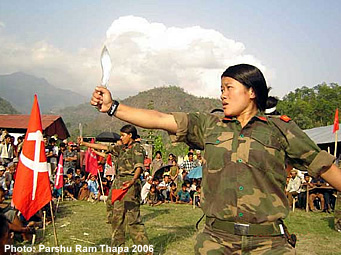 |
| Nepal 2008: Facts on the Conflict |
|
|
|
|
|
|
| Rehabilitation of Maoist combatants remains key challenge |
KATHMANDU, 30 October 2008 (IRIN)
 |
|
Rehabilitating the combatants is crucial for the successful conclusion of the peace process, say UNMIN officials. However, the issue remains controversial.
Local conflict analysts believe the only way to rehabilitate rebel soldiers - who spent most of their lives undergoing military training and engaging in violent activities - is to find them alternative jobs.
They said the only options seem to be recruiting them into security forces, the police force or the army.
Yet their integration into the army, which the Maoist leaders have been demanding, has proven a subject of controversy among the political parties.
In
2006, the Maoist rebels and Nepalese government signed an historic peace
agreement
"There
is a danger of mutiny inside the Nepal Army if the former rebels are integrated,"
said one analyst, who asked not to be identified.
The PLA combatants and army were sworn enemies during the conflict and often engaged in bloody combats, said the experts.
The analysts added that the failure to resolve the issue of rehabilitating the Maoist soldiers would jeopardise the peace process.
"No peace process can be said to be complete while there are two armies in one country," said Ian Martin, chief of UNMIN.
He added that a special committee representing key national parties was being formed for the integration and rehabilitation of Maoist combatants.
Integration concerns
However, key political parties like the Nepali Congress (NC), Madhesi Janadhikar Forum (MJF) and the Communist Party of Nepal-Unified Marxist Leninist (CPN-UML) are concerned over Maoist attempts to go for a full-scale integration between the army and the PLA.
"There would be new conflict if they forcefully integrate PLA into the army," warned Arjun Narsingh KC, senior leader and an army spokesman. The Communist Party of Nepal-Maoist (CPN-M), was quick to refute this charge, however.
"Apart from the national army, the PLA members could be inducted into the police force or industrial security force. They will not be forced to join the army," said Defence Minister and senior Maoist leader Ram Bahadur Thapa.
That modality of integration between the army and PLA has yet to be agreed upon at the political level, however, he said.
"Army integration is an important aspect of the peace process," said Thapa, explaining that a new national army would be formed after integration and in line with a new national security policy for the Himalayan nation.
| Credit
IRIN 2008 Copyright © UN Office for the Coordination of Humanitarian Affairs 2008 [ This report does not necessarily reflect the views of the United Nations] |
Integrated Regional Information Networks (IRIN), part of the UN Office for the Coordination of Humanitarian Affairs (OCHA).
| Links |
| External Links |
| ReliefWeb | OCHA |
| Information |
|
|
|
 |

